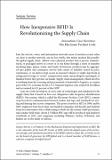How Inexpensive RFID Is Revolutionizing the Supply Chain: (Innovations Case Narrative: The Electronic Product Code)
Author(s)
Sarma, Sanjay E
Downloadinov_a_00138.pdf (634.9Kb)
PUBLISHER_POLICY
Publisher Policy
Article is made available in accordance with the publisher's policy and may be subject to US copyright law. Please refer to the publisher's site for terms of use.
Terms of use
Metadata
Show full item recordAbstract
Like the electric, water, and information networks most of modern society relies on, there is another network, one far less visible, that makes modern life possible: the global supply chain. Almost every physical product that is grown, manufactured, or packaged arrives at a store or at our home through a series of transfers involving ships, planes, trains, and trucks. In between, products may be aggregated into pallets and containers; moved with cranes or forklifts; stored in ports, warehouses, or on shelves; kept secure in armored vehicles or vaults; kept fresh in refrigerated storage or “reefer” transportation units; and packaged, repackaged, or finished before they get into our hands. Supply-chain management, which involves everything from the sourcing and procurement of materials to logistics, is a major part of the U.S. economy. In 2011, U.S. business logistics costs totaled $1.28 trillion
and accounted for 8.5 percent of the GDP.
Date issued
2012-07Department
Massachusetts Institute of Technology. Department of Mechanical EngineeringJournal
Innovations: Technology, Governance, Globalization
Publisher
MIT Press - Journals
Citation
Sarma, Sanjay. “How Inexpensive RFID Is Revolutionizing the Supply Chain: (Innovations Case Narrative: The Electronic Product Code).” Innovations: Technology, Governance, Globalization 7, no. 3 (July 2012): 35–52.
Version: Final published version
ISSN
1558-2477
1558-2485